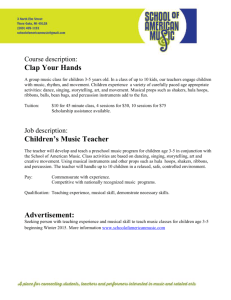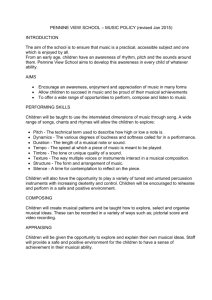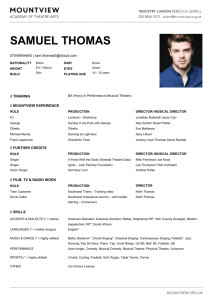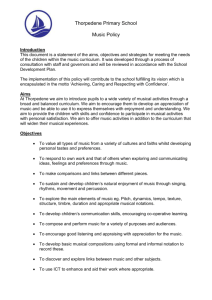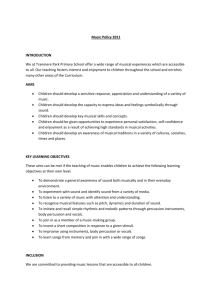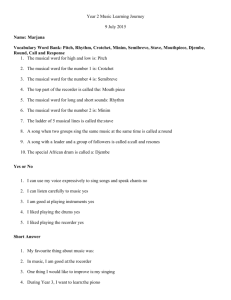overview of foundation stage and key stage 1 syllabus
advertisement
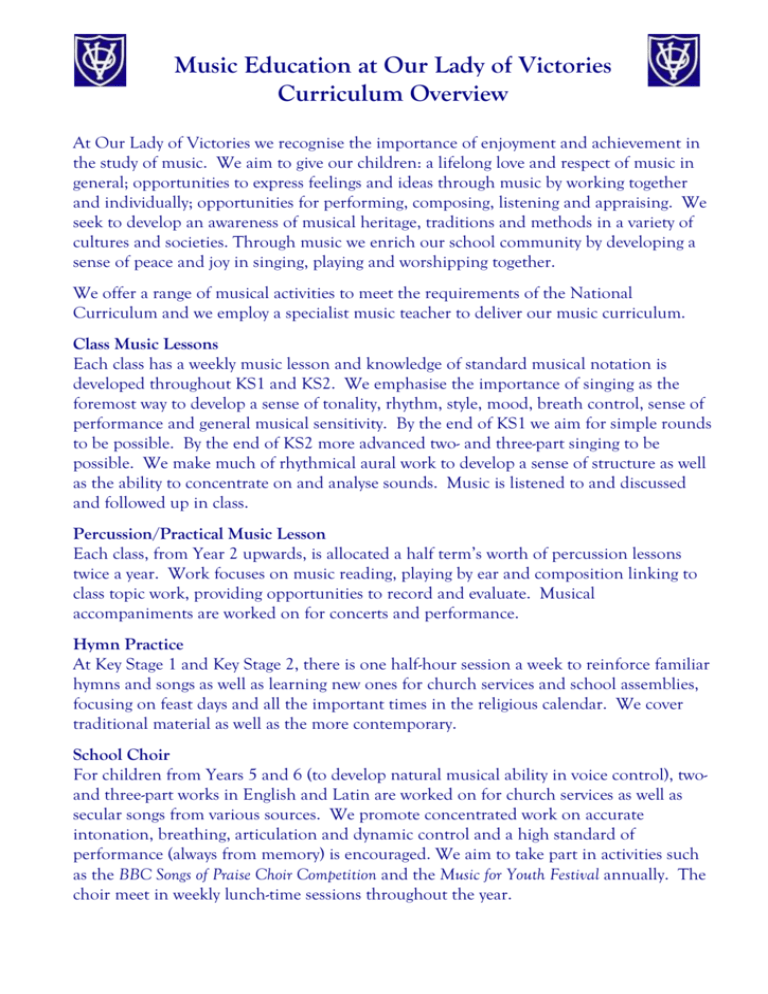
Music Education at Our Lady of Victories Curriculum Overview At Our Lady of Victories we recognise the importance of enjoyment and achievement in the study of music. We aim to give our children: a lifelong love and respect of music in general; opportunities to express feelings and ideas through music by working together and individually; opportunities for performing, composing, listening and appraising. We seek to develop an awareness of musical heritage, traditions and methods in a variety of cultures and societies. Through music we enrich our school community by developing a sense of peace and joy in singing, playing and worshipping together. We offer a range of musical activities to meet the requirements of the National Curriculum and we employ a specialist music teacher to deliver our music curriculum. Class Music Lessons Each class has a weekly music lesson and knowledge of standard musical notation is developed throughout KS1 and KS2. We emphasise the importance of singing as the foremost way to develop a sense of tonality, rhythm, style, mood, breath control, sense of performance and general musical sensitivity. By the end of KS1 we aim for simple rounds to be possible. By the end of KS2 more advanced two- and three-part singing to be possible. We make much of rhythmical aural work to develop a sense of structure as well as the ability to concentrate on and analyse sounds. Music is listened to and discussed and followed up in class. Percussion/Practical Music Lesson Each class, from Year 2 upwards, is allocated a half term’s worth of percussion lessons twice a year. Work focuses on music reading, playing by ear and composition linking to class topic work, providing opportunities to record and evaluate. Musical accompaniments are worked on for concerts and performance. Hymn Practice At Key Stage 1 and Key Stage 2, there is one half-hour session a week to reinforce familiar hymns and songs as well as learning new ones for church services and school assemblies, focusing on feast days and all the important times in the religious calendar. We cover traditional material as well as the more contemporary. School Choir For children from Years 5 and 6 (to develop natural musical ability in voice control), twoand three-part works in English and Latin are worked on for church services as well as secular songs from various sources. We promote concentrated work on accurate intonation, breathing, articulation and dynamic control and a high standard of performance (always from memory) is encouraged. We aim to take part in activities such as the BBC Songs of Praise Choir Competition and the Music for Youth Festival annually. The choir meet in weekly lunch-time sessions throughout the year. School Chamber Choir An opportunity for fifteen extremely able singers taken from the School Choir to meet in weekly lunch-time sessions in the summer term, leading up to the end-of-year summer concert. The children will be excellent music readers, very musically confident and enjoy working in a very concentrated manner on three-part secular music. A high standard of performance (always from memory) is always encouraged. Recorders From Year 2 onwards, children learn the Descant Recorder and, therefore, how to read music in weekly class lessons of half-an-hour in length. From Year 5, Treble Recorder lessons are also offered as extra-curricular activities. Opportunities to perform regularly in assemblies/hymn practices and end-of-term/year concerts are considered very important in the development of confidence and platform/concert manner and protocol. Regular practice and therefore a high standard of performance are always encouraged. Opportunities to work towards Associated Board Grade examinations are offered from Year 5 upwards in Descant and/or Treble Recorder. School Recorder Consort This meets once a week in a break time and consists of the most able (technically and musically) 15 or so recorder players from Years5/6. They provide a very high standard of performance for others to aim towards, working on a varied repertoire of three- and fourpart music for Descant, Treble, Tenor and occasionally Bass Recorders. Sight reading skills become well developed and the Consort perform at school concerts and also aim to play at festivals such as Music for Youth. School Concerts and Festivals KS2 instrumental and choral concerts take place at the end of the autumn and summer terms. These include works from cantatas, musicals and compositions/arrangements from music lessons. The opportunity to perform is seen as vital in developing confidence and a recognition of excellence. Appearing at a Music for Youth Regional Festival is an annual event that Years 5/6 work towards in the spring term. School Productions A KS1 musical and dramatic production is performed every Christmas with all children appearing on stage and singing/dancing/acting extensively in full costume (all from memory). A KS2 musical and dramatic production is performed at the end of every summer term with all children involved. Class Topic Work Links with class topic work are made with percussion compositional work and song learning whenever relevant or required. Violin Violin lessons are offered in small group lessons from Year 2. Opportunities to perform in all school concerts, take part in out-of-school courses and work towards AB exams are in place. OLV Music Festival A day-long festival of music takes place at the end of each spring term, offering the opportunity for individual performances on any instrument (with or without accompaniment) to parents and an adjudicator – at present, local concert pianist Mr Robert Bridge. All performances are commented on and particularly successful ones are acknowledged and awarded prizes. All players receive a certificate and comment sheet. Any child from Year 2 upwards may take part individually or in a group performance. OVERVIEW OF FOUNDATION STAGE AND KEY STAGE 1 SYLLABUS Musical Elements General introduction to sound – body sounds, sounds all around progressing onto characteristics of sound. Pitch: High/low – high/middle/low and introducing in terms of solfa as “doh-soh-doh”. Usage of simple notations and progressing onto reading the treble stave in Year Two with the completion of the solfa system. Usage of stories, games and songs to develop sense of pitch, eg., Goldilocks and the Three Bears (high/middle/low voices). Introduction of major and minor modes through happy/sad idiom. Duration: Beginning with long/short. Introducing pulse/beat (through heartbeat) and moving onto rhythm involving much clapping aural work and simple notation in the beginning of Reception, progressing onto standard notation at the end of Year Two. Dynamics: Working from loud to quiet to silence (using body sounds, for example in stories) to getting louder/quieter using < > signs and different ways of increasing or reducing volume, for example by adding more voices or just using individual breath control. Tempo: Introducing fast/slow by speech, movement and actions, everyday objects linking to duration work and again involving clapping. Developing independence within group work: some children clapping a slow line and others on fast. Timbre: Developing the idea of the type or quality of sounds we hear involving listening and discussion and then percussion work, for example: rattling, smooth, bouncy and tinkling. Structure: Starting in Reception with the beginning/end concept and moving on to length of bars, length of melodies and equal balancing phrases; recognising rhythmic patterns within a phrase. Texture: Distinguishing between one sound played alone and several played together, involving games with percussion instruments (for example, ‘Who is playing?’) and listening work with the piano playing in chords and then simple lines. Listening and appraising: Mood, dynamics, textures, effects created and instruments used to be discussed. During KS1 some multicultural music to be listened to and linked with topic work, e.g African drum music. Composition: In Reception and Year 1, simple work creating instrumental and body sounds to accompany songs and stories. In Year 2, in percussion lessons, linking with topic work, using relevant words as rhythmic starters, to provide musical ideas. Simple form and structure to be discussed and worked on. Results to be recorded, simply notated and evaluated. General: Introduce the different families of instruments using recorded music and pictures to illustrate. All these areas of music are to be interlinked to develop overall musical knowledge and skills, as well as providing a hugely rewarding and enjoyable area of the curriculum. OVERVIEW OF KS2 SYLLABUS Musical Elements Pitch: Developing sense of pitch involving aural training (with intervals), solfa work and notation (encouraging fluency in reading treble stave). During Years 5/6, an introduction to sight singing is approached. Terms such as scale and arpeggio (moving by steps or leaps) as well as the previously introduced major/minor notes are to be familiarised. By year 4, an elementary understanding of keys is being developed involving knowledge of the relevant accidentals. By Year 6, some recorder players work in keys of up to three sharps and flats. Duration: Rhythmic patterns are to be frequently discussed. Time signatures are to be introduced as an extension of work on bar structure; also the introduction to the beating of time (simple two, three four beats in a bar). Detailed rhythmic work, again involving aural training and reading of notation, to be undertaken. Dynamics: Different levels of P (pp mp) and F, etc., to be covered (including crescendo and diminuendo). This work is to be linked to voice control and effects achieved by dynamic contrast. Tempo: From discussion and identification of different tempi, and how these affect a song or piece of music, to Italian terms used to direct musicians. Timbre: Concept of the quality of musical sound – bright, hollow, mellow, poignant. By listening to music and discussing quality of sounds produced, children may consider achieving certain effects in their own compositional work. Texture: For example, talking about thick or thin sound, concept of melody/accompaniment and the use of chords to give a block sound. To involve percussion work as well as listening and appraising. By Year 6, to link to a simple introduction to style in music, e.g., Baroque – linear contrapuntal style as opposed to Romantic more chordal melody/accompaniment. Structure: From simple form (beginning/middle/end) to question/answer idea (linking with rhythmic work and composition), rounds and ostinato work. To introduce the more popular dance forms such as a waltz or march and to discuss the rhythmic features involved. Games: Used to develop rhythmic sense, independence and concentration. Using games such as rhythm rounds encourages reading and fluency in performance. Other clapping games develop the ability to hold a steady line and not to get faster (to follow a conductor’s beat). Extensive use of echo clapping/singing also to be undertaken. Listening and Appraising: Following through in chronological order from Medieval Music to the modern day, works are listened to and discussed/appraised throughout the school year. This is alternated the following year with various works connecting to the study of the elements of music. Popular works for children, such as Holst’s The Planets, are used as well as lesser known repertoire. A sound knowledge of the four sections of the orchestra and the different instrumental characteristics as well as the structure of the compositions is also covered. Links to creative writing, dance and drama are made wherever relevant. A study of popular music and that from different cultures and ethnic groups is also covered and linked with compositional percussion work as well as singing. Composition: To be developed in class music/singing lessons and percussion lessons. Work leads on from Q/A phrases (in rhythms and then melodies) and leads on to balanced phrases with melody/accompaniment and ostinato bass. Work links to class topic work using relevant words or ideas as starter points for rhythms and melodies. Results are recorded and evaluated. Classes write and perform one Christmas Carol during KS2. Children work on their own words (poetry) and melodic lines, discussing ideas together and producing a class composition to be performed at the Christmas concert. General: To discuss and appraise the different orchestral sections, with listening work, pictures and concert visits. Years 5/6 to cover keyboard layout in preparation for secondary school work. All these areas of music are to be interlinked to develop overall musical knowledge and skills, as well as providing a hugely rewarding and enjoyable area of the curriculum.
